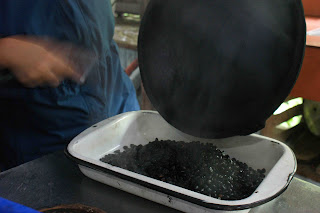At 19,347 ft. Cotopaxi is
one of the world’s tallest active volcanoes. I had been planning to climb it
since I found out I would be studying in Ecuador, so I was very excited when I
finally had a free weekend.
My friend from my program and I decided to climb it together. We planned the trip Ecuadorian style: on Monday we
called a guide that a friend had used and asked if he could take us up that coming weekend. “Sure!” he said, “I climbed it last weekend too and the conditions
were great.” He said he would call us later that week to tell us what we needed
to bring.
On Wednesday we emailed him asking about important specifics like a time
and place to meet and what type of gear we needed to bring. We got a reply on
Thursday with such atrocious spelling and lack of grammar that we had to send
it to an Ecuadorian friend to translate it into Spanish. It turned out his first
language wasn’t Spanish, but Quichua, a dialect common in rural parts of
Ecuador.
We decided after the email experience that communication by phone was
easier, so after confirming on Friday night we left at 6:30 am on Friday to
take the bus out to Cotopaxi. For $0.25 we took an hour and a half bus ride
down to the very south of Quito, and then for $3.00 we took another hour and a half bus ride
out to a town close to Cotopaxi National Park. There we met our guide in the
bus terminal and he took us to rent our gear. He turned out to be a great guide - very knowledgeable and a great cook. He has climbed Cotopaxi over 200 times!
Picking out our gear
We stopped at a nice viewpoint on the drive from the town to the volcano.
After getting all suited up
we hopped in the car and started driving up to the volcano. We stopped to buy
all the essential provisions: coca leaves, coca caramels, snickers bars, and
Gatorade.
We left the car in the
parking lot, strapped on our backpacks and started the hike to the refuge. The
hike was pretty slow going because of the slippery gravel, our heavy backpacks,
and the high altitude.
Taking a break on the way up to the refuge
A lot of people go up to the refuge for a day trip. As we were hiking up we saw a bunch of people playing in the snow. We were so tired just walking we couldn't imagine how they were running up and down the slopes.
When we got up to the refuge
we claimed beds for the night, unpacked a few things, and ate lunch prepared by
our guide. The refuge was much bigger than I though and can sleep over 100 people. In a nearby snow bank we practiced walking with our ice picks and
following in the footsteps of the guide.
We ate dinner around 6 pm in
order to be in bed by 7 pm. The plan was to wake up at 11 pm and start climbing.
It takes 5-8 hours to summit, so by leaving at 11 pm or midnight, you hopefully
summit just as the sun is rising.
However on this weekend the
weather was so bad that most groups (there were about 80 people at the refuge)
didn’t make it up. Another group from my university had to turn around 2 hours
from the top because their guide got sick, and in the morning we saw another
couple that didn’t make it up because of the wind and fog. We only made it up about 2
hours because the friend I was climbing it had a combination of altitude
sickness and food poisoning.
So we didn’t have the kind of
adventure we were expecting, but we did have an adventure: we got to tromp
around in the snow, drink coca tea, meet some new people, see some beautiful
views, and learn how to use ice picks. This was also the highest elevation I
have ever been at. I’m not sure how high we hiked up to, but the refuge is at 15,748
ft. I didn’t feel the altitude too much when we were walking slowly, but in the middle of
the night I woke up completely out of breath gasping for air.
I hope to go back and try to
climb it again. The part we did climb was gorgeous. We started out with another
group, and looking ahead all I could see was a long line of headlamps snaking
up the mountain. It was almost meditative hiking through the snow with only the
sound of the wind and heaving breathing. It felt like we were completely
isolated in our own world on the volcano, completely separate from time and our
normal lives.





























































